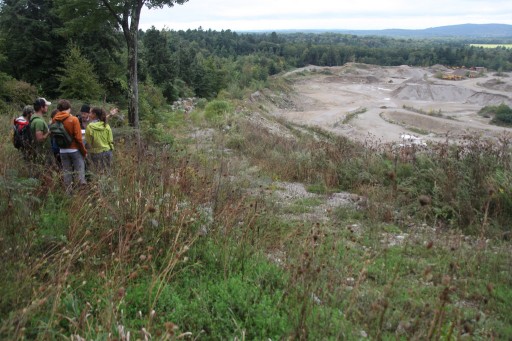After hiking inside the Battell Research Forest, we aimed to characterize the forested landscape according to patterns observed in both abiotic and biotic characteristics throughout our walk. We aimed to explain the existence of these patterns through analysis of their intersection.
Located on the western slope of the Green Mountain foothills in Vermont’s Champlain Valley, the Battell Research Forest, approximately 0.5 square km, is, according to Northup, part of the some 60,000 acres of lands set aside in 1911 by Joseph Battell to be preserved “in their original and primeval condition.” Although the land has undergone moderate timber extraction in the past, its natural domination by economically undesirable hemlock trees has made it mostly unattractive for logging, and it has subsequently been largely preserved. The most noticeable disturbance is a significant mining operation taking place directly at the base of the slope. Today, the area is covered with both hemlocks and hardwoods of all ages as a result of the selective logging and mining-associated human disturbance that has taken place there.
During the lab, we walked a 1.52 mile loop that covered a significant part of the forest’s Northeastern-most quadrant, tracking our progress as we went using a GPS device, also aided by compasses and topographic maps. The heterogeneity of the landscape was manifested at several different scales, in topography, soil type and depth, as well as species diversity, age structure, and distribution.
Based on our observations, human intervention seems to play a prominent role in the biotic composition of land, with the areas closest to the mining operation now dominated by hardwoods. Variations in slope depth and aspect were also prominent abiotic features of the landscape, but it was difficult to draw clear conclusions based on our observations in regards to whether or not these factors affected the landscape’s biotic composition.
This lab revealed how the complex heterogeneity of a landscape at any level is not isolated to a single scale, and instead can manifest itself on multiple scales throughout the landscape. In attempting to draw conclusions about the complex interplay of the various factors in the landscape (both abiotic and biotic), we also discovered the challenge of attempting to extrapolate larger cause-and-effect relationships from limited field observations.
Written by Molly Rose-Williams and Paul Quackenbush.


